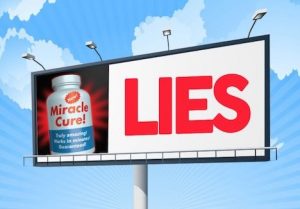 Horse owners are faced with new claims for products or devices all the time, and I get lots of questions about them, along the lines of, “Should I use this or not?” I thought it might be fun and instructive to look at one of those products and go through my thought processes in hopes that it will help you negotiate the device-infested waters that you have to swim your horse through on your own (although I’m happy to help). I decided to look at MagnaWave®, a device with which I have no experience, but about which I’ve received numerous questions.
Horse owners are faced with new claims for products or devices all the time, and I get lots of questions about them, along the lines of, “Should I use this or not?” I thought it might be fun and instructive to look at one of those products and go through my thought processes in hopes that it will help you negotiate the device-infested waters that you have to swim your horse through on your own (although I’m happy to help). I decided to look at MagnaWave®, a device with which I have no experience, but about which I’ve received numerous questions.
First of all, let’s set 10 ground rules for examining claims (keep them in mind whatever you’re looking at).
- There should be some good scientific studies supporting whatever it is. I don’t want to just see a list of studies; I want to see what the studies have to say. It turns out that some products say they are supported by science when they aren’t, or may offer up some scientific study that doesn’t say what the seller said it says. Show me the science so I can see for myself.
- In addition to some scientific studies, I’d like for the studies to be current. If the study listed is from 1992, I’m generally not as persuaded it it’s something more recent.
- Results of studies should be directly applicable to what I’m concerned about. Some study that concluded that a therapy did “something” under some test condition doesn’t impress me nearly as much as one that examines a particular therapy being used for a particular condition.
 I also want to know how things turned out long-term, not how they looked at some hand-picked point in time.
I also want to know how things turned out long-term, not how they looked at some hand-picked point in time.- Testimonials mean zero. It doesn’t matter to me if it’s coming from “Lithuania’s most popular and well-known horse vet” or from an earnest owner. First of all, testimonials can be easily purchased. In addition, even if a testimonial is sincere, it’s usually impossible for an individual to know if a product actually did anything, since the horse is usually trying to heal itself anyway.
- False statements disqualify something from consideration, and particularly so if they keep coming up.
- If something claims to provide a treatment for a condition which has no known cure, I’m very skeptical. When there’s cure for something, everyone uses it.
- Claims need to be defined. Things that “support,” “improve,” or claim to be bigger/better/faster are meaningless. For example, if something’s supported, I want to know what needs supporting, why it needs to be supported, exactly how that support is delivered, and have proof that the support actually did something meaningful for the horse.
- Medical mumbling – claims that sound good but are actually meaningless – is a big red flag.
- If a therapy claims to be helpful in the treatment of everything, it’s probably not very helpful in the treatment of anything.
So, with those rules, let’s head to the website at https://magnawavepemf.com/
 Right off the bat, I’m a bit worried. The site claims that the device, “Helps keeps horses healthier for longer” (#9). That’s quite a claim, and I’m not even sure how one would measure it. I mean, does it keep them from aging? Prevent hoof abscesses? Provide sweet music to the microflora of the horse’s intestinal tract? Let’s dismiss that advertising copy and move on. My naturally skeptical eye is already a bit worried.
Right off the bat, I’m a bit worried. The site claims that the device, “Helps keeps horses healthier for longer” (#9). That’s quite a claim, and I’m not even sure how one would measure it. I mean, does it keep them from aging? Prevent hoof abscesses? Provide sweet music to the microflora of the horse’s intestinal tract? Let’s dismiss that advertising copy and move on. My naturally skeptical eye is already a bit worried.
The first page is also loaded with very sincere sounding – albeit grammatically awkward – testimonials. For example, one horse was allegedly given “an extra two years (of quality life)” as a result of treating melanomas with the device, although I have no idea how one might determine such a thing since nobody knows how long the horse was going to live in the first place (#9). In addition, nobody knows how to cure melanomas, much less how long a horse with melanomas is going to live (often, old age gets them before the melanoma does).
Finishing up with the first page, I note that there’s a “Product Recommendation Tool.” I didn’t really get into that, but I’m pretty sure that if a company that’s selling a product comes up with a “tool” to recommend they’re own product, it’s a bit like asking the bank robber to guard the bank. There’s at least a potential problem.
 Next, on to, “Who We Are.” Turns out that Magna-Wave is a family-owned company, started by a fellow named Pat Ziemer. That said, there’s a family-owned restaurant down the street, but I go there because the food is good, not because it’s family-owned. Now as far as I know, Mr. Ziemer is a super nice guy who loves kids, pets his dogs regularly, and would never have a mean thought about anyone. However, according to his LinkedIn page at https://www.linkedin.com/in/patziemer/ he also has zero medical training. He got a BS in Mass Communications and Media Studies in 1972 from the University of Southern Indiana, and was certified in Magnawave™ in 2000 (but, curiously, that certification apparently expired in 2001). The point of this is not to cast any aspersions whatsoever on the founder of the company, however, I really prefer getting my medical advice from people who have studied medicine. Sadly, I’ve found out that sometimes the earnest health advice that comes from someone who doesn’t have any medical background actually isn’t all that good. The “team” page has a whole bunch of smiling people on it (including three Ziemers),
Next, on to, “Who We Are.” Turns out that Magna-Wave is a family-owned company, started by a fellow named Pat Ziemer. That said, there’s a family-owned restaurant down the street, but I go there because the food is good, not because it’s family-owned. Now as far as I know, Mr. Ziemer is a super nice guy who loves kids, pets his dogs regularly, and would never have a mean thought about anyone. However, according to his LinkedIn page at https://www.linkedin.com/in/patziemer/ he also has zero medical training. He got a BS in Mass Communications and Media Studies in 1972 from the University of Southern Indiana, and was certified in Magnawave™ in 2000 (but, curiously, that certification apparently expired in 2001). The point of this is not to cast any aspersions whatsoever on the founder of the company, however, I really prefer getting my medical advice from people who have studied medicine. Sadly, I’ve found out that sometimes the earnest health advice that comes from someone who doesn’t have any medical background actually isn’t all that good. The “team” page has a whole bunch of smiling people on it (including three Ziemers),
On to, “The MagnaWave Difference.” Here’s what sets MagnaWave apart from other companies. “First and foremost, MagnaWave is a family…” Now this is just me I’d prefer that what sets it (or any other company or product) apart is that it has a product that affects some aspect of horse health in a demonstrably positive way, but I digress. Another advantage is that it, “… has the longest warranty in the industry.” See list, 1 – 4.
ASIDE: I can’t help but notice that the conference that the company sponsors is called, “MagnaCon.” I’m just saying.
Since evidence for effectiveness is, so far, pretty elusive, let’s look at the FAQ page. In case you didn’t know, a FAQ is a list of questions and answers relating to a particular subject, especially one giving basic information for users of a website. If you didn’t know, one has to be a bit careful with FAQs, since they are asked and answered by the individual(s) posting them, who, presumably, are also affiliated with the company (the bank robber guarding the bank thing). That said, this is a pretty great place to see how the claims made get along with actual facts (#5 on the list).
- What is MagnaWave? – Well, here are some highlights. “Pulsed electromagnetic fields are used to cover low energy cells in raw, pure energy.” Nope – magnetism is a force, but it has no energy of its own. “The entire body is electrical.” Nope – nerve certainly transmit via electrical gradients generated by chemical ions, but the whole body isn’t electrical (water, which makes up most of the body, for example, isn’t electrical and doesn’t hold an electrical charge). Plus, if you started messing with the body’s electricity by inducing an electrical charge, you’d likely have a lot of unintended consequences to deal with. See #6 on our list.
 Is PEMF safe for everyone to use? – “MagnaWave machines are not medical machines and do not treat or cure diseases or their symptoms.“ First off, they didn’t answer the question. Second, while I appreciate the honesty, since these aren’t medical machines, it seems to me that the next question would be, “What’s the point of using them for treating medical conditions?”
Is PEMF safe for everyone to use? – “MagnaWave machines are not medical machines and do not treat or cure diseases or their symptoms.“ First off, they didn’t answer the question. Second, while I appreciate the honesty, since these aren’t medical machines, it seems to me that the next question would be, “What’s the point of using them for treating medical conditions?”- How long has MagnaWave been used or been available? “PEMF technology has existed for hundreds of years, dating back to somewhat primitive civilizations…” Well, nope (again – #6). The English physicist William Sturgeon made the first electromagnets back in the 19th century (CLICK HERE to read more about William Sturgeon). On the other hand, magnets were first noticed thousands of years ago, and have been tried repeatedly as therapies. One particularly notable example is the story of the German physician Franz Mesmer, who made a career out of pushing his magnetic therapies in the royal courts of Paris (CLICK HERE to read more about his wild story).
- What are the Veterinary Regulations in my states? There’s a link – but it’s dead.
Well… we’re now 0 for 4 (to use baseball terminology) when it comes to the veracity of the FAQs, and a lot of the other questions on the page have to do with machine purchase and financing, so let’s go back to look for some science.
It’s actually not that easy to find any science on the site. I did find some claims, specifically that:
“MagnaWave for Horses Can Help:
- Tendon and Ligament Injuries
 Sore Backs
Sore Backs- Sore Stifles
- Chronic Hock Soreness
- Sore Shoulders
- Non-Union Fractures
- Gastric Ulcers
- EPM
- Colic
- Laminitis
- Stone Bruises
- Non-Healing Wounds”
As for those, see #9 on my list. “Helping” is a meaningless term – it’s just medical mumbling. I also didn’t find any links to scientific studies supporting the treatment for any of these things with the device, however, there is a link to an “Equine Business Bundle” at the bottom of the page. Again. Sigh.
Undaunted (I am not easily daunted), I kept looking. Finally, in the “Education Center,” I did find a whole slew of recent articles on the purported usefulness of the product for a whole slew of conditions for which treatment can be frustrating, e.g., EPM, anhidrosis, hoof abscesses, rattlesnake bites, and open wounds. That’s great, I guess, but, once again, it takes me back to number 9.
 AT LAST, SOME SCIENCE (SORT OF)
AT LAST, SOME SCIENCE (SORT OF)
In looking even deeper, I did find some links to a couple of studies in the “Open Wounds” article. At last, some science! So, let’s take a look at those studies. At the end of the article are five sources, a couple of which were also listed earlier in the article. So, let’s look at those.
“Veterinary applications of pulsed electromagnetic field therapy.” https://www.sciencedirect.com/science/article/pii/S003452881830208X
This one, published in 2018, isn’t a scientific study. Rather, it’s a review article. Now review articles are fine, but they are noted for being biased (that’s just a oft-documented fact). In fact, at the end of the review, one also sees that two of the three authors work for a company that makes PEMF machines, which brings us back to the potential problem with banks being guarded by bank robbers. The review has a few positive studies and a few negative studies, a bit of history, but nothing about horses. Personally, I’m not really impressed by “promising” therapies.
“Evaluation of treatment with a pulsed electromagnetic field on wound healing, clinicopathologic variables, and central nervous system activity of dogs.” https://www.ncbi.nlm.nih.gov/pubmed/9736399
If you’re a horse owner, you might be tempted by bypass this one, since it’s about dogs (I probably would). Nevertheless, it’s up there, so let’s see what it says. The study is from 1998, which is OK, but that runs into a problem with #2 on my list. If you look at the conclusion, you find, “The PEMF treatment enhanced wound epithelialization in open cutaneous wounds and provided indications of early contraction without significant short-term changes in other variables.” What does that mean?
Well, it means that a few days after these wounds were created in 12 dogs, a couple of things seemed to be better, but nothing else really changed. We don’t know if the treatment made any difference in terms of healing outcomes. A couple of things changed – most didn’t. If you look at enough things, you’re bound to find some difference in something if you pick a point in time. Call me unimpressed.
 Pulsed electromagnetic fields (PEMF) promote early wound healing and myofibroblast proliferation in diabetic rats –https://www.ncbi.nlm.nih.gov/pubmed/24395219
Pulsed electromagnetic fields (PEMF) promote early wound healing and myofibroblast proliferation in diabetic rats –https://www.ncbi.nlm.nih.gov/pubmed/24395219
If you are particularly drawn to diabetic rats, I am awed by your commitment to their health. I can’t even imagine the time you spend giving the little fellers insulin shots every day. However, it’s kind of hard to say that this sort of study has any relevance whatsoever to horses (who also don’t get diabetes). That said, the researchers concluded, “We demonstrated that significantly more myofibroblasts were detected on days 7 and 10 post-wounding in the PEMF group when compared to the control group.”
My response to this is a resounding, “So what?” What did that mean for the wounds? Did they heal faster or better? How much time was saved? How much money was spent? If a wound heals one day faster, and it costs $500 to get there, one can ask if the treatment was worth it.
https://www.theinstituteofnaturalhealth.com/about1-c1f1j This one’s not a scientific study at all. It’s a testimonial.
https://www.iaat.org.uk/case-studies/20/Scientific-Report-of-PEMF-Therapy-on-Wound-Healing The link’s dead on this one.
CONCLUSION
So, what do I make of all this? I think it’s fun to try this sort of analysis. When you do it, you find that much of what is being offered to horse owners is likely to be of questionable value. To me, if a therapy is safe, proven, and effective, the most effective way to advertise it would be to say, “This therapy is safe, proven, and effective,” and then go about providing the proof for everyone to see. The MagnaWave® site doesn’t do that. Call me unconvinced.







